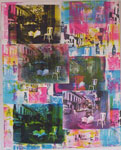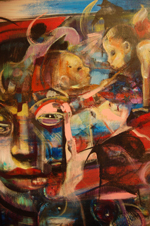 When
Joe Kelley was organizing the current Church
| State exhibit for the
Bucktown Center for the Arts, artist Les Bell asked him: "Is this
going to be a blue show or a red show?" Kelley recalled.
When
Joe Kelley was organizing the current Church
| State exhibit for the
Bucktown Center for the Arts, artist Les Bell asked him: "Is this
going to be a blue show or a red show?" Kelley recalled.
In an interview this week, Kelley said he was hoping to find something in between: "I was hoping it would be a purple show."
It's curious that two arenas that are often best kept separated - art and politics - share the language of color. Blue signifies the Democrats on the electoral map, and red the Republicans. And red used to represent the threat of communism, whose adherents were of course called pinkos.
Yet those color labels reduce complex subjects and issues - even the populations of entire regions - and rob them of nuance.

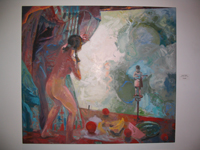 Les
Bell is well-known in the Quad Cities area for his teaching at St.
Ambrose University, his wide intelligence, and his colorful and
sensitive use of the nude in his art. There are few artists who can
so easily paint the human figure as the primary subject of their
work. The new Leger Gallery, in downtown Davenport, is presently
hosting a 10-year retrospective of his paintings.
Les
Bell is well-known in the Quad Cities area for his teaching at St.
Ambrose University, his wide intelligence, and his colorful and
sensitive use of the nude in his art. There are few artists who can
so easily paint the human figure as the primary subject of their
work. The new Leger Gallery, in downtown Davenport, is presently
hosting a 10-year retrospective of his paintings.
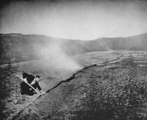 The
images of Robert and Shana ParkeHarrison - at the Figge Art Museum
through October 29 - transport us through narrative image to a
world that is parallel to our own, but oddly vacant and visually
strange, owing largely to things being out of scale, a lack of color,
and metaphorical structures such as gears turning beneath the surface
of the earth.
The
images of Robert and Shana ParkeHarrison - at the Figge Art Museum
through October 29 - transport us through narrative image to a
world that is parallel to our own, but oddly vacant and visually
strange, owing largely to things being out of scale, a lack of color,
and metaphorical structures such as gears turning beneath the surface
of the earth.
 When
Bill Hannan first met Jeanne Tamisiea in the 1980s, she was one of
three finalists for a teaching position on the fine-arts faculty at
Black Hawk College. "You could tell right off the bat that she was
a teacher," Hannan said. "If you are a teacher, you can spot
one."
When
Bill Hannan first met Jeanne Tamisiea in the 1980s, she was one of
three finalists for a teaching position on the fine-arts faculty at
Black Hawk College. "You could tell right off the bat that she was
a teacher," Hannan said. "If you are a teacher, you can spot
one."
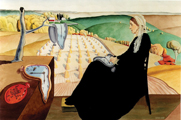 DeVilbiss
has run the festival for the vast majority of its 19 years - he
returned three years ago when MidCoast Fine Arts took over the event
- but he'll be leaving after this weekend's edition, being held
Saturday and Sunday in the Village of East Davenport's Lindsay
Park. (The River Cities' Reader
is a sponsor of the event. A Riverssance map is located on the back
cover of this week's issue.)
DeVilbiss
has run the festival for the vast majority of its 19 years - he
returned three years ago when MidCoast Fine Arts took over the event
- but he'll be leaving after this weekend's edition, being held
Saturday and Sunday in the Village of East Davenport's Lindsay
Park. (The River Cities' Reader
is a sponsor of the event. A Riverssance map is located on the back
cover of this week's issue.)
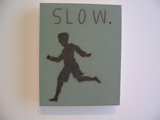 Viewing
the work of an artist who has been making art for decades is like
looking at an iceberg. You see the little part that is showing but
not the hidden part, which is years of study, making art, learning
about oneself, and inventing.
Viewing
the work of an artist who has been making art for decades is like
looking at an iceberg. You see the little part that is showing but
not the hidden part, which is years of study, making art, learning
about oneself, and inventing.
 You open the door and are engulfed by the plump and relentless beats from the DJ. The cave-like basement has pockets of illumination that attract buzzing swarms of twenty- and thirty-somethings to clusters of art, like chicly clad insects to an irresistible bug zapper. The art ranges from jarring paintings, whimsical sketches, and disconcerting collages to kinetic sculptures with whirling wheels of spurs and cast turds on a stick gathered in some kind of dookie Stonehenge.
You open the door and are engulfed by the plump and relentless beats from the DJ. The cave-like basement has pockets of illumination that attract buzzing swarms of twenty- and thirty-somethings to clusters of art, like chicly clad insects to an irresistible bug zapper. The art ranges from jarring paintings, whimsical sketches, and disconcerting collages to kinetic sculptures with whirling wheels of spurs and cast turds on a stick gathered in some kind of dookie Stonehenge.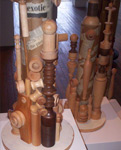 "In my nightmare, black ominous towers vibrating with negative energy, producing a very low and constant humming sound, surround a picturesque little cottage with a flower garden and a white picket fence. A little girl steps out of the cottage and into the garden, where she bends over to pick a daisy. I yell, 'Don't pick the flowers,' and then I awaken. I knew that the flower was the trigger that would detonate the black towers (nuclear missiles) surrounding her."
"In my nightmare, black ominous towers vibrating with negative energy, producing a very low and constant humming sound, surround a picturesque little cottage with a flower garden and a white picket fence. A little girl steps out of the cottage and into the garden, where she bends over to pick a daisy. I yell, 'Don't pick the flowers,' and then I awaken. I knew that the flower was the trigger that would detonate the black towers (nuclear missiles) surrounding her."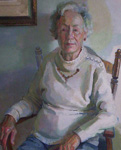 Stacey is just kickin' back. She has her hair pulled up with a red and white bandanna, and her feet are resting on a pale-blue footstool. The calmness in her face and smooth tonal transitions in her skin initially stand in contrast with the house party of color in the afghan draped behind her wooden chair.
Stacey is just kickin' back. She has her hair pulled up with a red and white bandanna, and her feet are resting on a pale-blue footstool. The calmness in her face and smooth tonal transitions in her skin initially stand in contrast with the house party of color in the afghan draped behind her wooden chair.